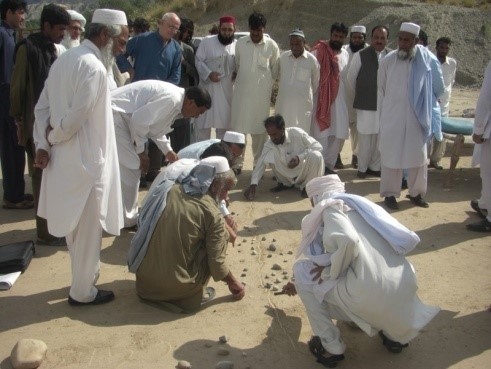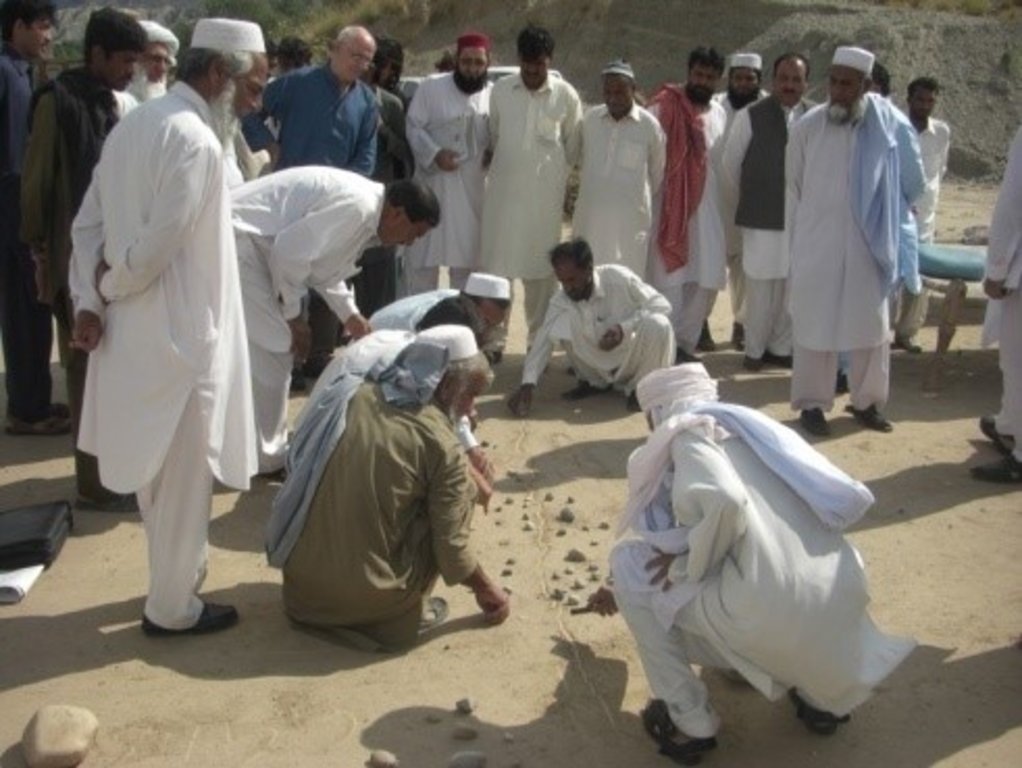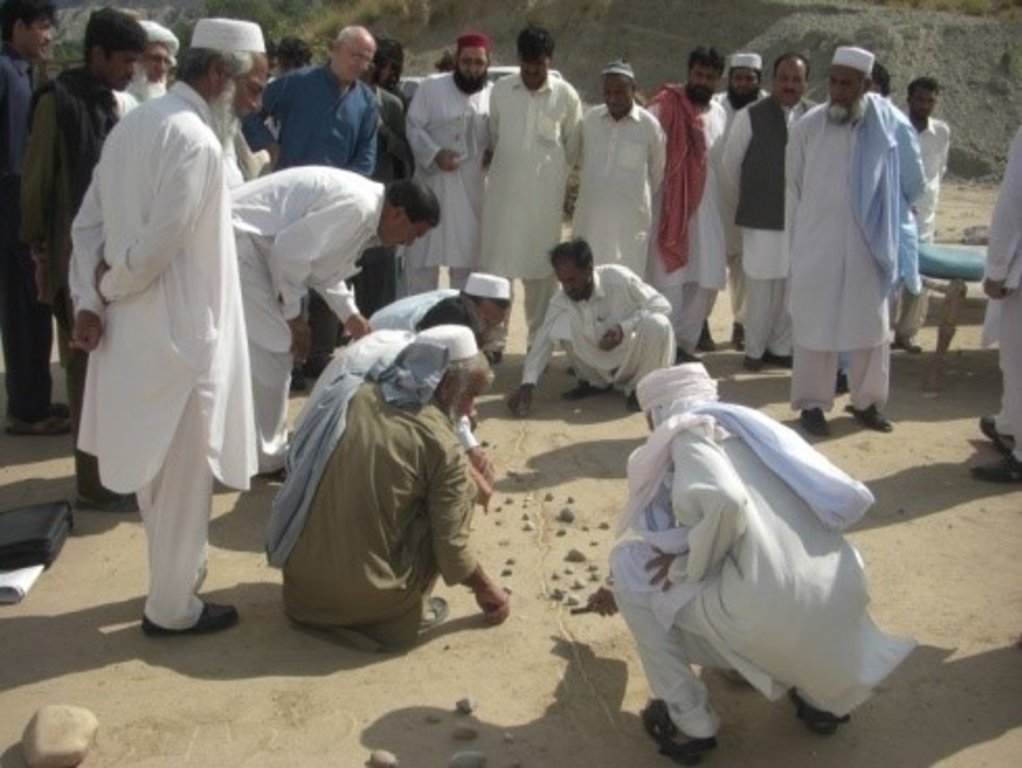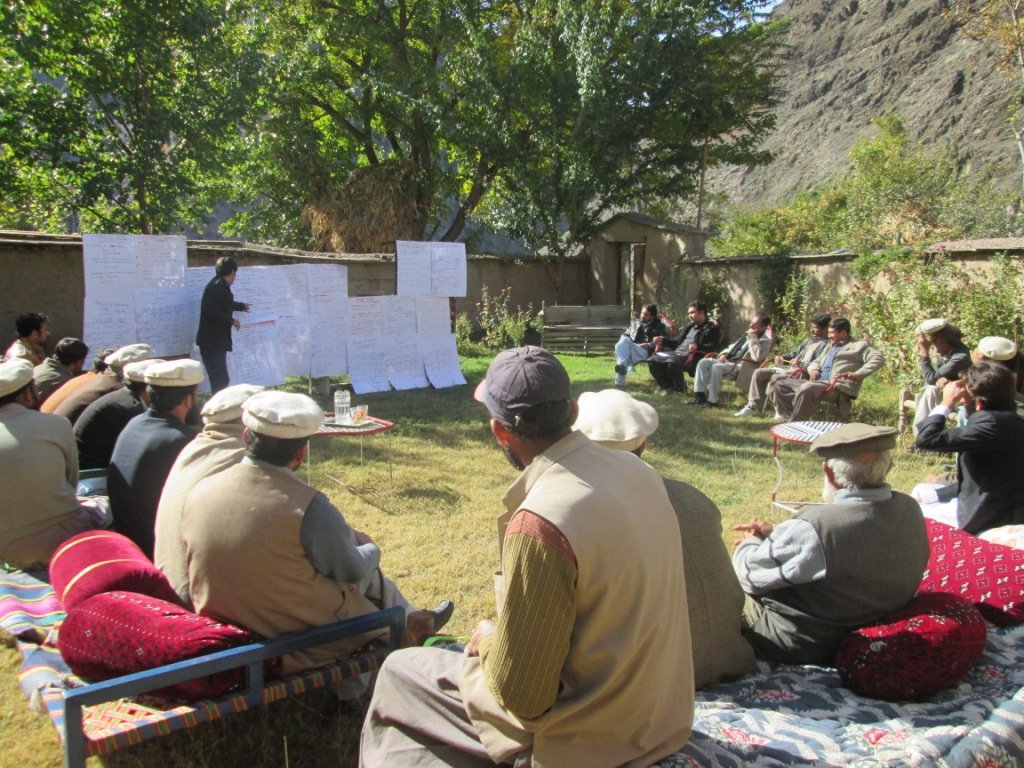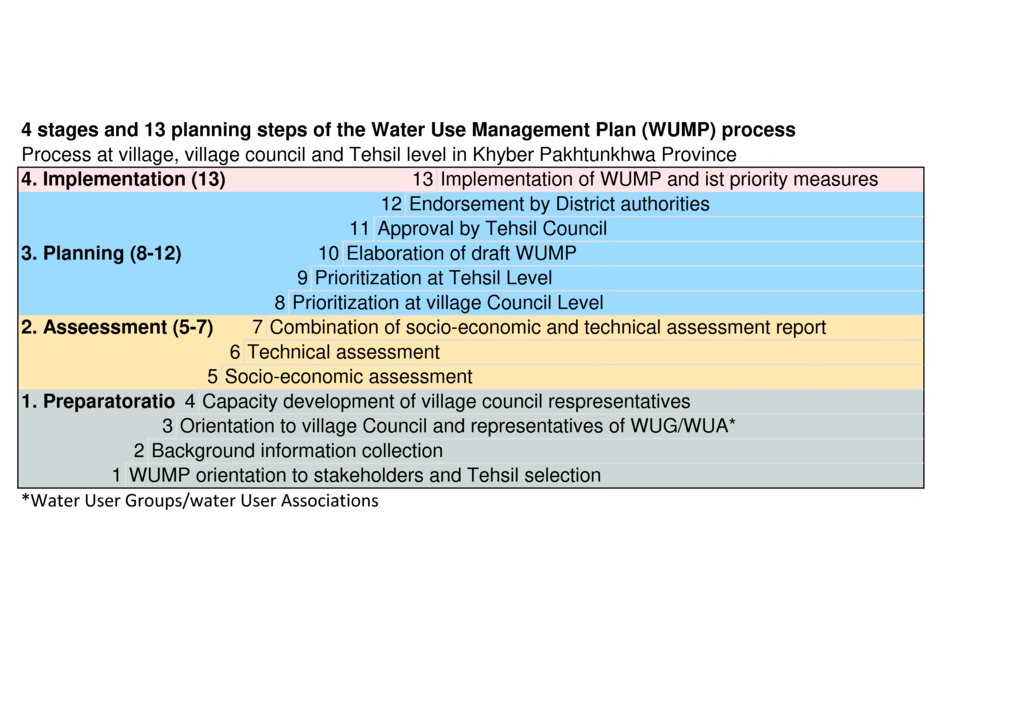Water Use Management Plan (WUMP) [Pakistan]
- Création :
- Mise à jour :
- Compilateur : Eveline Studer
- Rédacteur : Munawar Khan
- Examinateurs : Alexandra Gavilano, Nicole Harari, Hanspeter Liniger
WUMP
approaches_747 - Pakistan
Voir les sections
Développer tout Réduire tout1. Informations générales
1.2 Coordonnées des personnes-ressources et des institutions impliquées dans l'évaluation et la documentation de l'Approche
Nom du projet qui a facilité la documentation/ l'évaluation de l'Approche (si pertinent)
Book project: where people and their land are safer - A Compendium of Good Practices in Disaster Risk Reduction (DRR) (where people and their land are safer)Nom du ou des institutions qui ont facilité la documentation/ l'évaluation de l'Approche (si pertinent)
HELVETAS (Swiss Intercooperation)1.3 Conditions relatives à l'utilisation par WOCAT des données documentées
Quand les données ont-elles été compilées (sur le terrain)?
15/11/2014
Le compilateur et la(les) personne(s) ressource(s) acceptent les conditions relatives à l'utilisation par WOCAT des données documentées:
Oui
1.4 Références au(x) questionnaire(s) sur les Technologies de GDT
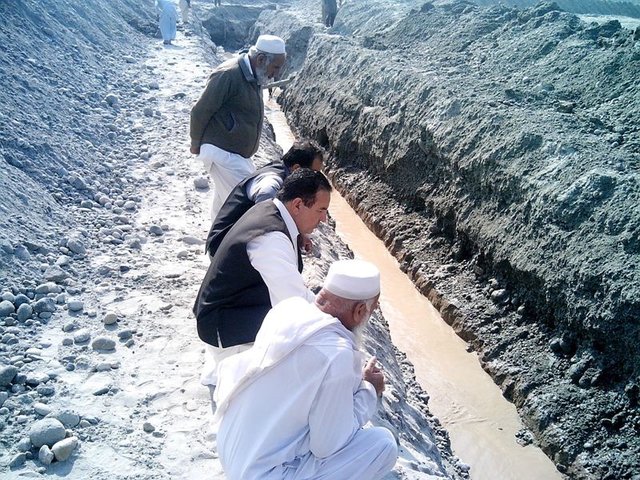
Sub-surface water harvesting for an efficient use of … [Pakistan]
The purpose of this water harvesting technology is to capture, collect and distribute sub-surface water. First, an infiltration gallery is developed, which allows the percolation and collection of sub-surface water through perforated pipes at a depth of approximately 3-4.5 metres. Sub-surface water is filtered by gravel/sand underground and infiltrates into …
- Compilateur : Eveline Studer
2. Description de l'Approche de GDT
2.1 Courte description de l'Approche
The overall purpose of WUMP is to compile an inventory of available water ressources in a particular geographical or administrative area, to identify communities' priorities in order to achieve an effective, equitable and efficient use of water resources at local level. This approach promotes a participatory and inclusive analysis and implementation of measures for a sustainable management of water, land and related resources.
2.2 Description détaillée de l'Approche
Description détaillée de l'Approche:
The WUMP approach has the following specific objectives:
- to assess water available resource, existing uses and requirements
- to determine water access rights and equity issues through inclusive and interactive dialogues
- to plan and manage water resources - considering multiple needs and uses - in a participatry manner.
- to prioritise required measures, considering climate change and disaster risks
- to promote coordinated water resource development for different stakeholders
- to promote a sustainable use of water, protecting water resources and preservation of the environment
- to strengthen local institutions
- to include economically and socially disadvantaged groups
- to promote an interactive dialogue for improvement of regulatory frameworks and policies in the water sector.
The methode involves field visits by field team to collect information from the community, which is done through focus group discussion, preparation of village maps, social and technical questionnaires
The WUMP process consists of four main stages: 1) Preparation; 2) Assessment/analysis of information ; 3) Planning ; 4) Implementation (see flow chart with according sub-steps).
The process and results of a WUMP:
Is based on a participatory process, which promote inclusiveness. It fosters coordination and collaboration among different local stakeholders including government, communities and private sector and helps to establish the baseline situation and a comun understanding. Land users and other local actors appreciate this approach as it promotes a participatory, transparent process for an equitable distribution of water and a sustainable management of water related resources. The approach helps to overcome potential economic or socio-cultural barriers, by providing a comun space for joint analysis, discussion and solution finding by facilitating interaction between stakeholders of different contexts.
2.3 Photos de l'approche
2.5 Pays/ région/ lieux où l'Approche a été appliquée
Pays:
Pakistan
Région/ Etat/ Province:
Dera Ismail Khan Thensil (sub-division), Khyber Pakhtunkhwa (province)
Map
×2.6 Dates de début et de fin de l'Approche
Indiquez l'année de démarrage:
2014
Date (année) de fin de l'Approche (si l'Approche n'est plus appliquée):
2019
Commentaires:
The approach remains valid and applicable also after the termination of a project intervention.
2.7 Type d'Approche
- fondé sur un projet/ programme
2.8 Principaux objectifs de l'Approche
The main aim of the WUMP approach is to assess the availability of water resources, existing uses/demands and future requirements/needs. The WUMP helps to address water access, equity issues and balance these rights through interactive dialogues within the community and other local stakeholders. The WUMP approach contributes therefore actively to water governance and improved management of natural resources.
2.9 Conditions favorisant ou entravant la mise en œuvre de la(des) Technologie(s) appliquée(s) sous l'Approche
normes et valeurs sociales/ culturelles/ religieuses
- favorise
The approach helps to overcome potential economic or socio-cultural barriers, by providing a comun space for joint analysis, discussion and solution finding by facilitating interaction between stakeholders of different contexts.
disponibilité/ accès aux ressources et services financiers
- favorise
The implementation of the WUMP tends to increase access to water for production purposes with a positive impact for households/ communities' income.
The results of the WUMP process with its according priorities of intervention are recognized by local government and reflected in local annual development plans and according budgets.
- the WUMP defines options for other actors to investment in water sector based on communities' priorities.
cadre institutionnel
- favorise
WUMP is steered by the district Coordination Committee at district level having representative from all concerned government departments, Water User Association including women members, representatives from civil society where they adress key issues and take decisionsof the local water sector.
collaboration/ coordination des acteurs
- favorise
Collaboration among actors is the central element of the WUMP, which pomotes a coordinated water resource development involving different stakeholders: communities and government and non-governmental organizations. The process, enables local institutions to consider needs and participation of economically and socially disadvantaged groups.
cadre juridique (régime foncier, droits d'utilisation des terres et de l'eau)
- favorise
WUMP addresses and defines solutions on water access & equity issues through interactive dialogues.
cadre politique
- favorise
WUMP can influence sector policies at local level based on the collections of baseline data and evidence, which contributes to improve frame conditions. Topics, priorities and challenges of the WUMP are addressed with stakeholders at district Coordination Committee, which can actively influence policies of the water sector.
connaissances sur la GDT, accès aux supports techniques
- favorise
The local stakeholders, namely communities are directly involved in the implementation of the WUMP, which improves their knowledge about SLM.
3. Participation et rôles des parties prenantes impliquées dans l'Approche
3.1 Parties prenantes impliquées dans l'Approche et rôles
- exploitants locaux des terres / communautés locales
Rural local communities, water & land users
Participation as an integral part in preparation at village level. Contribution to the assessment, prioritisation and implementation of the interventions
- organisations communautaires
Water user associations (WUA)/ water users groups (WUG)
Responsible to support and facilitate the WUMP process, social support, provision of primary information. Ensure participation and involvement of all WUA members. Coordinate with relevant authorities and other development actors to identify technical and financial support in their area / water sector.
- Spécialistes de la GDT/ conseillers agricoles
staff of the Water for Livelihoods Project : WUMP coordinator (engineer, male, 53 years), senior engineer (engineer, male, 43 years)
Coaching and guidance at all level, steering of WUMP process in collaboration with District Government, organize trainings as scheduled, support field teams for the collection of technical and social information/data.
- ONG
Local partner NGO
Project implementation, social mobilisation and interaction at field level to ensure that the social dimension, local concerns deserving support are adressed and that the water user association (WUA) are inclusive and gender concerns are duly represented. Support water user associations in their advocacy efforts to mobilize resources for WUMP.
- secteur privé
Consultant
Compilation of data, collected information and writing of WUMP
- gouvernement local
District Authorities / Administration
Provision of legal and administrative acceptance, recognition and support to WUMP implementation. Support through provision of timely technical services to water user association /groups in WUMP implementation, validation of information (data regarding drinking water supply, irrigation, water use efficiency, soil conservation by Public Health Engineering Department, Irrigation Department, On Farm Water Management Department, Soil Conservation Department ). Participation to ensure a participatory monitoring and provide feedback to the district govt. for improvements in delivering of water sector services.
- gouvernement national (planificateurs, décideurs)
District and provincial governments
Policy dialogue counter-part to address WUMP issues, which require a change in policies, coordination and engagement with in-line authorities and to allocate resources for the integration and implementation of WUMP in the district development plan (ADP).
- organisation internationale
Swiss Agency for Development and Cooperation (SDC)
Financial ressources. Partner for advocacy and policy dialogues to address key topics in the water sector in their policy dialogue with national government representatives.
Si plusieurs parties prenantes sont impliquées, indiquez l'organisme chef de file ou l'institution responsable:
Water for Livelihoods Project
3.2 Participation des exploitants locaux des terres/ communautés locales aux différentes phases de l'Approche
| Participation des exploitants locaux des terres/ communautés locales | Spécifiez qui était impliqué et décrivez les activités | |
|---|---|---|
| initiation/ motivation | interactive | Community through water user association (WUA) and water user group (WUG) in their actvities: support and facilitate the WUMP, ensure that all WUGs are involved in the process, link with relevant authorities and other development actors for technical and financial support development. |
| planification | interactive | Community: WUA/WUG in their activities: Participate as an integral part in the preparation of WUMP at village level. Contribute to conducting feasibility, implementation and execution of interventions. |
| mise en œuvre | interactive | Community: WUA/WUG in their activities: Support a system for cost contribution by the community. Link with relevant authorities and other development actors for seeking the technical and financial support in their area water sector development. Promote and advocate for sustainable development in the water sector. |
| suivi/ évaluation | interactive | Community: WUA/WUG in their activities: Ensure equitable water rights and promote good water governance principles. Ensure strong linkages with WUA/community through regular meetings and documentation of decisions. |
3.3 Diagramme/ organigramme (si disponible)
Description:
The process of WUMP is divided into 4 stages consisting of 13 steps
Auteur:
Syed Hussain Mustafa, Khan Muhammad, Tawheed Gul, Munawar Khan Khattak
3.4 Prises de décision pour la sélection de la Technologie/ des Technologies
Indiquez qui a décidé de la sélection de la Technologie/ des Technologies à mettre en œuvre:
- tous les acteurs concernés dans le cadre d'une approche participative
Expliquez:
The technology is selected via mutual consensuses at village council level. This process is facilitated by a SLM specialist. Women - as well as other vulnerable and marginalized groups - are also part of the water user association and participate in the discussion and decision making process. Where joint setting of men & women is not possible due to cultural constraints, separate meetings of men & women are conducted to cover the voices and concerns of both.
Spécifiez sur quelle base ont été prises les décisions:
- l'évaluation de connaissances bien documentées en matière de GDT (prises de décision fondées sur des preuves tangibles)?
- expériences et opinions personnelles (non documentées)
4. Soutien technique, renforcement des capacités et gestion des connaissances
4.1 Renforcement des capacités/ formation
Une formation a-t-elle été dispensée aux exploitants des terres/ autres parties prenantes?
Oui
Spécifiez qui a été formé:
- exploitants des terres
- personnels/ conseillers de terrain
- Government department specilist (SLM)
Formats de la formation:
- sur le tas
- entre agriculteurs (d'exploitants à exploitants)
- réunions publiques
Thèmes abordés:
Water resources conservation, efficient use of water resources, irrigation water distribution/ scheduling.
Commentaires:
Water Users are trained in different techniques of water conservation, such as water crop budgeting, local flow measuring techniques, irrigation scheduling with regard to specific crops.
The users are specifically trained in techniques for efficient water use, such as furrow irrigation, raised bed irrigation, mulching etc.
4.2 Service de conseils
Les exploitants des terres ont-ils accès à un service de conseils?
Oui
Spécifiez si le service de conseils est fourni:
- dans les champs des exploitants?
- dans des centres permanents
Décrivez/ commentez:
SLM specialist made field visits and provided technical guidance to Land Users
The Land Users visited relevant organizations for technical guidance
4.3 Renforcement des institutions (développement organisationnel)
Des institutions ont elles été mises en place ou renforcées par le biais de l'Approche?
- oui, modérément
Spécifiez à quel(s) niveau(x), ces institutions ont été renforcées ou mises en place:
- local
Décrivez l'institution, ses rôles et responsabilités, ses membres, etc.
Water User Association (WUA, local Institutions) at district & sub-district level were strengthened. The legally recognize WUA and Apex of the WUA take gradually responsibilities to support and facilitate the WUMP process. The WUAs strives for improvements in the water sector and are a catalyst to bring together and pool communities, civil society organisations, local authorities and other actors of different actors for to address water issues and development options.
Précisez le type de soutien:
- renforcement des capacités/ formation
Donnez plus de détails:
Project provided trainings for 16 Water User Associations (WUAs) and 3 Apex WUAs in Chitral, Karak, and DI Khan. These 16 associations aim to improve development in the water sector, to improve water governance to contribute to resolutions in case of disputes amongst different water right holders for an equitable access to water at local and at district level.
Through these trainings, the WUGs/ WUAs members representing various groups/ associations - including representatives from Government Line Agencies are trained in community management & skill training, mediation in case of water disputes, monitoring/documentation and health/hygiene.
4.4 Suivi et évaluation
Le suivi et l'évaluation font ils partie de l'Approche? :
Oui
Commentaires:
The principle of the monitoring, is to actively engage the communities associations (WUA/WUG) and capture their observations and concerns.
This is done through direct feedbacks from communities, during regular field visits and interaction with technical departments, who receive feedbacks from communities based on regular exchanges.
Si oui, ce document est-il destiné à être utilisé pour le suivi et l'évaluation?
Non
Commentaires:
This documentation is not primarily used for monitoring & evaluation purpose. However it contributes to establish a baseline.
4.5 Recherche
La recherche a-t-elle fait partie intégrante de l’Approche?
Non
5. Financement et soutien matériel externe
5.1 Budget annuel de la composante GDT de l'Approche
Si le budget annuel précis n'est pas connu, indiquez une fourchette:
- 2 000-10 000
Commentez (par ex. principales sources de financement/ principaux bailleurs de fonds):
The cost for the preparation of WUMP depends on the size of the area
5.2 Soutiens financiers/ matériels fournis aux exploitants des terres
Les exploitants des terres ont-ils reçu un soutien financier/ matériel pour la mise en œuvre de la Technologie/ des Technologies?
Oui
Si oui, spécifiez le(s) type(s) de soutien, les conditions et les fournisseurs:
The project and governamental counter parts (Department) provide material and technical support. The community provides in-kind contribution through labor and local material for the imlementation of the measures/ technology.
5.3 Subventions pour des intrants spécifiques (incluant la main d'œuvre)
Si la main d'œuvre fournie par les exploitants des terres était un intrant substantiel, elle était:
- volontaire
5.4 Crédits
Des crédits ont-ils été alloués à travers l'Approche pour les activités de GDT?
Non
5.5 Autres incitations ou instruments
D'autres incitations ou instruments ont-ils été utilisés pour promouvoir la mise en œuvre des Technologies de GDT?
Non
6. Analyses d'impact et conclusions
6.1 Impacts de l'Approche
Est-ce que l'Approche a autonomisé les exploitants locaux des terres, amélioré la participation des parties prenantes?
- Non
- Oui, un peu
- Oui, modérément
- Oui, beaucoup
The approach supports land and water users to make decisions regarding water use by their own.
Est-ce que l'Approche a permis la prise de décisions fondées sur des données probantes?
- Non
- Oui, un peu
- Oui, modérément
- Oui, beaucoup
The preparation stage includes an analysis, where information for evidence and later decisions is collected. Once the effectiveness of the approach is recognized, it can be replicated by other communities them-selfs.
Est-ce que l'Approche a aidé les exploitants des terres à mettre en œuvre et entretenir les Technologies de GDT?
- Non
- Oui, un peu
- Oui, modérément
- Oui, beaucoup
Land users are involved for the implementation and maintenance of the prioritized measures in the WUMP plan, which an efficient use water for productiion and drinking purposes.
Est-ce que l'Approche a amélioré la coordination et la mise en œuvre de la GDT selon un bon rapport coût-efficacité?
- Non
- Oui, un peu
- Oui, modérément
- Oui, beaucoup
The WUMP provides options for cost sharing mechanisms amongst different actors, to attract funding for prioritized initiatives. The prioritized initiatives of WUMP are jointly implemented by different stakeholders, which can reduce its costs.
Est-ce que l'Approche a mobilisé/ amélioré l'accès aux ressources financières pour la mise en œuvre de la GDT?
- Non
- Oui, un peu
- Oui, modérément
- Oui, beaucoup
The results of WUMP (measures) are included in the official departmental annual development plans and budgets.
Est-ce que l'Approche a amélioré les connaissances et les capacités des exploitants des terres pour mettre en œuvre la GDT?
- Non
- Oui, un peu
- Oui, modérément
- Oui, beaucoup
The land and water users learnt how to analyse and assess water resources. They learnt about options to address the identified challenges.
Est-ce que l'Approche a amélioré les connaissances et les capacités des autres parties prenantes?
- Non
- Oui, un peu
- Oui, modérément
- Oui, beaucoup
Similarly, all other involved stakeholders' learn how to analysse and asses water resources and know about options to address them.
Est-ce que l'Approche a construit/ renforcé les institutions, la collaboration entre parties prenantes?
- Non
- Oui, un peu
- Oui, modérément
- Oui, beaucoup
By establishing a district coordination committee to steer the approach (WUMP) all stakeholders can jointly discuss, address their needs and suggest options to be prioritized.
Est-ce que l'Approche a atténué les conflits?
- Non
- Oui, un peu
- Oui, modérément
- Oui, beaucoup
Through this approach all stakeholders - especially the up-stream & down stream users - can resolve their water related disputes through dialogue. This contributes to resolve disputes between communities and concerned department.
Est-ce que l'Approche a autonomisé les groupes socialement et économiquement défavorisés?
- Non
- Oui, un peu
- Oui, modérément
- Oui, beaucoup
Disadvantaged groups participate in the preparation process of the plan, where they reflect and contribute with their concerns, needs and priorities.
Est-ce que l'Approche a amélioré l'égalité entre hommes et femmes et autonomisé les femmes et les filles?
- Non
- Oui, un peu
- Oui, modérément
- Oui, beaucoup
Same participation as the disadvantaged groups. Women are also part of the decision making body.
Est-ce que l'Approche a encouragé les jeunes/ la prochaine génération d'exploitants des terres à s'engager dans la GDT?
- Non
- Oui, un peu
- Oui, modérément
- Oui, beaucoup
Same participation as the disadvantaged groups. Generall people of the age group 30-45 have are the leader of associations - supported by their elders - to address and develop water ressouce management of their villages.
Est-ce que l'Approche a conduit à améliorer la sécurité alimentaire et/ou la nutrition?
- Non
- Oui, un peu
- Oui, modérément
- Oui, beaucoup
Through the approach water efficient technologies are promoted, which allow to increase production and improve food security.
Est-ce que l'Approche a conduit à améliorer l'accès à l'eau et l'assainissement?
- Non
- Oui, un peu
- Oui, modérément
- Oui, beaucoup
Through the approach options to improve access to water for domestic use are promoted. Access to clean drinking water at households' proximity contributes to improved sanitation.
Est-ce que l'Approche a amélioré la capacité des exploitants des terres à s'adapter aux changements/ extrêmes climatiques et a atténué les catastrophes liées au climat?
- Non
- Oui, un peu
- Oui, modérément
- Oui, beaucoup
The result of the WUMP approach is a set of options, where efficient use of water and water saving technologies are promoted e.g. water harvesting.
6.2 Principale motivation des exploitants des terres pour mettre en œuvre la GDT
- augmenter la production
WUMP aims to improve access and availability of water. More water for irrgation and efficient water use technologies contribute to increased yields. Consequently surface for agricultural production can be extended.
- augmenter la rentabilité/ bénéfice, rapport coûts-bénéfices
By promoting efficient water utilization techniques, this can reduce costs, especially where power driven water pumping is involved.
- réduire la dégradation des terres
Earlier in areas of water scarcity flood irrigation, which leds to erosion, was applied. This approach helps to promote more sustainble irrigation options.
- réduire les risques de catastrophe
In the initial analysis stage of WUMP different water related hazards, mainly floods and droughts, are identified. As a result options to reduce according risks are identified and promoted.
- règles et règlements (amendes)/ application
This approach help in aligning the traditional rules with formal rules and regulation in water management. The associations are not only right holders but they are also duty barer to communities.
- conscience environnementale
The approach promotes a sustainable water resource management. It promotes conservation and balances it with an efficient use of water fo rdifferent purposes. At the assessment stage potential problems related to unsustainable practices are analized and addressed.
- améliorer les connaissances et compétences en GDT
Communities are informed and empowered to identify and contribute to the implementation of options for sustainable water management.
- atténuer les conflits
This approach provide opportunity to all stakeholders especially the up-stream & down stream users to resolve water related disputes through a joint dialogue. It further contributes to resolve disputes between communities and govtl. departments.
6.3 Durabilité des activités de l'Approche
Les exploitants des terres peuvent-ils poursuivre ce qui a été mis en œuvre par le biais de l'Approche (sans soutien extérieur)?
- oui
Si oui, décrivez de quelle manière:
For the prioritisation of technologies implemented through WUMP, options which require only minimal external inputs and are easy to sustain by the land user, where promoted.
6.4 Points forts/ avantages de l'Approche
| Points forts/ avantages/ possibilités du point de vue de l'exploitant des terres |
|---|
|
Participatory and inclusive process, which ensures ownership by local actors, promotes coordination and fosters partnerships between different actors. |
| The proritized measures selected through the WUMP approach promote a sustainable use of water resources through water conservation and efficient water use. |
| Points forts/ avantages/ possibilités du point de vue du compilateur ou d'une autre personne ressource clé |
|---|
|
Strengthening of local institutional capacities, establishment ofan inventory/ data used as base line in the water sector. |
|
Flexible for improvement, since the WUMP is reviewed each 3-5 year |
| Officially recognized and accepted planning tool at regional level, which provides opportunities for investment by other actors based on communities' priorities. |
6.5 Faiblesses/ inconvénients de l'Approche et moyens de les surmonter
| Faiblesses/ inconvénients/ risques du point de vue de l’exploitant des terres | Comment peuvent-ils être surmontés? |
|---|---|
|
Time consuming preparation process, high initial cost for the preparation |
Ensure regular feature of planing (continuous process) |
| Lack of technical capacities at local level | Capacity building trainings of local institutions (VOs/ WUAs/WUGs) in planning. Provide suport at local level through the project and government extension services. |
| Faiblesses/ inconvénients/ risques du point de vue du compilateur ou d'une autre personne ressource clé | Comment peuvent-ils être surmontés? |
|---|---|
|
Replication and upscaling require talor-made adjustments |
Technical capacity building of govt. departments. |
| WUMP application in large scale in areas (big catchment areas, limited access) | Lobbying for support and resources at different governmental level. |
| Important mobilisation of resources by other stakeholders for implementation | Inclusion of WUMP priorities by the govt. department in their respective annual development plans. |
7. Références et liens
7.1 Méthodes/ sources d'information
- visites de terrain, enquêtes sur le terrain
- field visit all involved villages, organisation of focal group discussions
- interviews/entretiens avec les exploitants des terres
land user where the key informants.
- interviews/ entretiens avec les spécialistes/ experts de GDT
Meeting with technical departments for data/ information regarding their respective services and experience
- compilation à partir de rapports et d'autres documents existants
Support from secondary data/ reports of the concerned department, analysis of the primary data, compilation and reporting.
7.3 Liens vers les informations pertinentes disponibles en ligne
Titre/ description:
Water Use master Plan (WUMP) Project experience Nepal, Helvetas Swiss Intercooperation Nepal
URL:
https://assets.helvetas.org/downloads/13_waterusemasterplan_wump_blau_final_engl_a4_portrait.pdf
Titre/ description:
Water Use master Plan (WUMP) - facilitator's guide book, 2015, Helvetas Swiss Intercooperation Nepal
URL:
http://www.rainfoundation.org/wp-content/uploads/2016/04/Nepal-Module-final_SF.pdf
Liens et modules
Développer tout Réduire toutLiens

Sub-surface water harvesting for an efficient use of … [Pakistan]
The purpose of this water harvesting technology is to capture, collect and distribute sub-surface water. First, an infiltration gallery is developed, which allows the percolation and collection of sub-surface water through perforated pipes at a depth of approximately 3-4.5 metres. Sub-surface water is filtered by gravel/sand underground and infiltrates into …
- Compilateur : Eveline Studer
Modules
Aucun module trouvé


